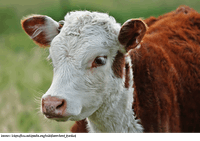BeefTalk: Controlling Cow Size Aids in Controlling Cow Costs
We all know most beef cows haven gotten bigger. Is that what we want? Kris Ringwall, Beef Specialist NDSU Extension Service provides these insights.

“Would a herd of 120 smaller-framed cows be a better fit than a herd of 100 larger-framed cows?” is an often-asked question throughout the beef industry.
The number of cows will vary, but for the sake of answering the question, let’s set the herd size as 120 smaller-framed cows and 100 larger-framed cows. The Dickinson Research Extension Center has explored the question since the mid ’90s.
Recently, we summarized some thoughts as we explored cow size, expanded the forage base, adopted May-June calving and retained ownership of calves. The net result was a 10 percent increase in revenue for the smaller-framed cows, when compared with the larger-framed cows, based on steer calf performance. Although the smaller-framed cows’ revenue per finished steer was lower, $821.81 versus larger-framed cows at $895.82, the total finished steer net return was $4,517 greater from the smaller-framed cow herd.

The final check showed smaller-framed cows earned $49,308 ($821.81 times 60 steers), while larger-framed cows earned $44,791 ($895.82 times 50 steers). The small-framed cow stocking rate was 20 percent more, resulting in the sale of 20 percent more steer calves.
This data is the result of research funded through the Sustainable Agriculture Research and Education (SARE) program and reported by visiting scholar Songul Sentürklü and center animal scientist Doug Landblom. Further information is available at the center’s website at http://tinyurl.com/DRECstockingrate.
In the fall, the traditional center cows average approximately 1,450 pounds. The smaller-framed, Lowline-influenced cow weighed in at approximately 1,100 pounds. These are data that generate more questions. In fact, cow size is a very debated and discussed beef topic, and it’s certainly a topic on the agenda for many beef producers because controlling costs is a major beef production issue.
Reviewing the data from years 2012 through 2014, following the switch to May-June calving, provides more insight to help answer producer questions. The center has identified three major cost-cutting points:
- First is a later calving date to decrease labor.
- Second is an intensified multiple-crop rotation that includes cover crops, harvesting some crops and grazing the majority of the acreages by cows, calves and yearlings to lower overhead.
- Third is controlling cow size to decrease inputs and increase ranch output.
As noted, the center has maintained two cow herds for several years, and the center collects fall cow weights. Back in 2008, a review showed the cow weight spread was very amazing and surprising. I made a simple chart that displayed the various cow weights within the center’s herd.
Leading the pack, and certainly eligible for boss cow status, were three cows just under a ton. The next 30 cows weighed from 1,895 to 1,700 pounds. The center had 86 cows that weighed from 1,695 to 1,500 pounds and 90 cows that weighed in at 1,490 to 1,305 pounds. As the cows got lighter, 52 cows weighed from 1,295 to 1,100 pounds. The 64 lightest cows weighed in under 1,100 pounds.
Because many factors affect cow size, several thoughts came to mind. The first factor is age, followed by breed, environment, nutritional history, stage of production and many other factors.

As a result of wanting to better understand the impact of cow size, the center essentially sold off Simmental Bullthe really big cows and the really small cows and split the remaining cows into what we would call a more traditional herd, with a targeted weight of 1,450 pounds, and a smaller-framed herd targeted to weigh 300 pounds lighter, at 1,150 pounds. Prior to 2008, the center had experience with Lowline genetics, and a 300-pound difference seemed achievable within a traditional Angus, Red Angus, Simmental and Hereford beef herd.
At this point, when a producer keeps calves to finish and takes advantage of appropriate stocking rates and practices good sire selection, controlling cow size is positive. Keep in mind, controlling cow size does not mean a particular size of cow will work everywhere because each operation and environment may support a particular size of cow.
However, controlling cow size does mean knowing one’s cows and what they weigh so that appropriate stocking rates can be achieved and implemented.
The other factor is sire selection. Herd sires that control frame, but support desired gain and carcass characteristics, need to be utilized. As a caution, decreasing the size of cattle is easy to do, thereby decreasing herd performance. However, the astute producers understand the genetics of cattle size and only then set out to decrease cow size with increased herd performance.
Questions remain, but for now, controlling cow size will help reduce costs and may add income.
Source: ndsu.edu